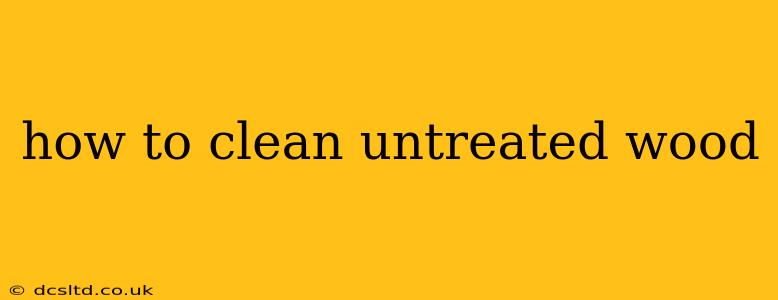Untreated wood, with its natural beauty and rustic charm, adds warmth and character to any space. However, keeping it clean and protected requires a gentle touch and the right techniques. This comprehensive guide will walk you through the best methods for cleaning untreated wood, addressing common concerns and ensuring its longevity.
What are the different types of untreated wood?
Before diving into cleaning methods, understanding the type of untreated wood is crucial. Different woods have varying levels of porosity and durability, influencing the best cleaning approach. Common types include pine, cedar, oak, and redwood, each with its own unique properties and susceptibility to damage. For example, softwoods like pine are more porous and absorbent, requiring more delicate cleaning than hardwoods like oak. Knowing your wood type will help you choose the appropriate cleaning method.
How do I clean untreated wood furniture?
Cleaning untreated wood furniture requires a gentle approach to avoid damaging the delicate surface. Avoid harsh chemicals and abrasive cleaners. Here's a step-by-step process:
-
Dusting: Regularly dust your furniture using a soft cloth or microfiber duster. This prevents dirt buildup and reduces the need for more intensive cleaning.
-
Spot Cleaning: For minor spills or stains, blot (don't rub!) the area immediately with a clean, damp cloth. Avoid excessive moisture, which can damage the wood.
-
Mild Soap Solution: For more thorough cleaning, prepare a solution of mild dish soap and warm water. Dip a soft cloth into the solution, wring it out thoroughly, and gently wipe the wood surface. Always test your cleaning solution on an inconspicuous area first.
-
Rinse and Dry: Rinse the wood surface with a clean, damp cloth to remove any soap residue. Then, immediately dry the wood thoroughly with a soft, clean cloth to prevent water damage.
-
Wood Polish (Optional): After cleaning, you can apply a natural wood polish or oil to enhance the wood's beauty and protect it from dryness and cracking. Choose a product specifically designed for untreated wood.
How to clean untreated wood floors?
Cleaning untreated wood floors requires a similar gentle approach but often involves larger areas.
-
Regular Sweeping or Vacuuming: Regularly sweep or vacuum your floors to remove loose dirt and debris, preventing scratches and damage. Use a soft-bristled broom or vacuum with a brush attachment.
-
Damp Mopping: Use a damp (not wet) mop with a mild wood floor cleaner. Avoid excessive water, which can cause warping or damage.
-
Targeted Cleaning: For stubborn stains or spills, use a specialized wood floor cleaner and follow the manufacturer's instructions. Again, blot rather than rub.
-
Drying: Ensure the floor is thoroughly dried after cleaning to prevent water damage. Use a clean, dry mop or cloths to absorb any excess moisture.
What's the best way to clean untreated wood countertops?
Untreated wood countertops require diligent care due to their exposure to food preparation and potential spills.
-
Immediate Cleaning: Clean up spills and messes immediately to prevent staining. Blot spills with a clean cloth.
-
Regular Wiping: Wipe down your countertops daily with a damp cloth.
-
Gentle Cleaning Solution: For deeper cleaning, use a mild soap and water solution, rinsing and drying thoroughly.
-
Cutting Boards: Always use cutting boards to protect your countertops from knife scratches and damage.
How often should I clean untreated wood?
The frequency of cleaning depends on the location and use of the wood. Furniture should be dusted regularly and spot-cleaned as needed. Floors might require daily sweeping or vacuuming and occasional damp mopping. Countertops need daily wiping and more thorough cleaning as needed.
What should I avoid when cleaning untreated wood?
Several things should be avoided when cleaning untreated wood:
-
Harsh Chemicals: Avoid using harsh chemicals, bleach, ammonia, or abrasive cleaners, as they can damage the wood's finish and color.
-
Excessive Water: Avoid soaking or over-wetting the wood, which can lead to warping, cracking, or mold growth.
-
Abrasive Materials: Avoid using abrasive materials like steel wool or scouring pads, which can scratch the wood's surface.
-
High Heat: Avoid placing hot pans or other hot items directly on the wood surface. Use trivets or pot holders.
By following these guidelines and choosing the appropriate cleaning methods, you can keep your untreated wood looking its best for years to come. Remember that prevention is key; regular dusting and spot cleaning will minimize the need for more intensive cleaning.
